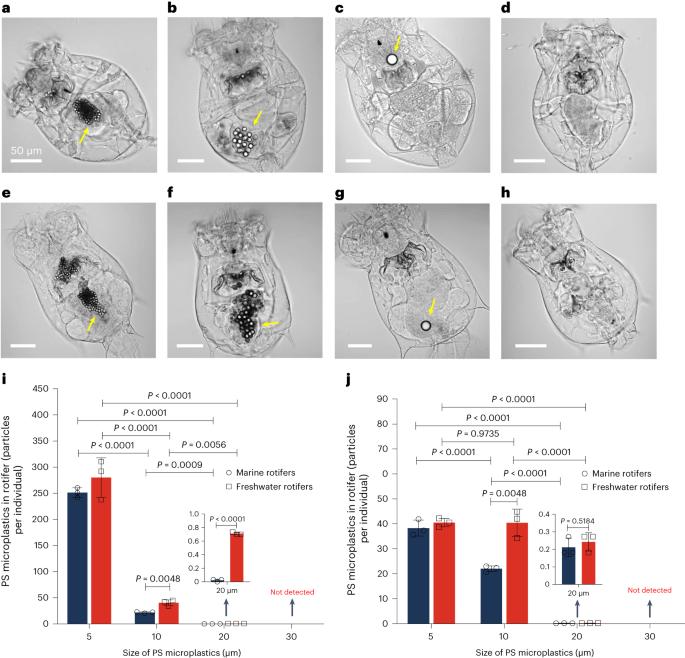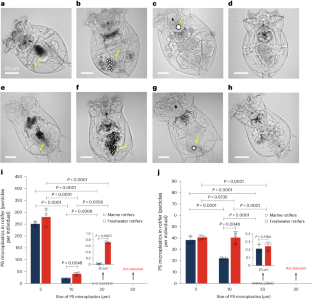Microplastic fragmentation by rotifers in aquatic ecosystems contributes to global nanoplastic pollution
IF 34.9
1区 材料科学
Q1 MATERIALS SCIENCE, MULTIDISCIPLINARY
引用次数: 0
Abstract
The role of aquatic organisms in the biological fragmentation of microplastics and their contribution to global nanoplastic pollution are poorly understood. Here we present a biological fragmentation pathway that generates nanoplastics during the ingestion of microplastics by rotifers, a commonly found and globally distributed surface water zooplankton relevant for nutrient recycling. Both marine and freshwater rotifers could rapidly grind polystyrene, polyethylene and photo-aged microplastics, thus releasing smaller particulates during ingestion. Nanoindentation studies of the trophi of the rotifer chitinous mastax revealed a Young’s modulus of 1.46 GPa, which was higher than the 0.79 GPa for polystyrene microparticles, suggesting a fragmentation mechanism through grinding the edges of microplastics. Marine and freshwater rotifers generated over 3.48 × 105 and 3.66 × 105 submicrometre particles per rotifer in a day, respectively, from photo-aged microplastics. Our data suggest the ubiquitous occurrence of microplastic fragmentation by different rotifer species in natural aquatic environments of both primary and secondary microplastics of various polymer compositions and provide previously unidentified insights into the fate of microplastics and the source of nanoplastics in global surface waters. Here the authors show that the trophi or jaws of the chitinous masticatory apparatus of marine and freshwater zooplankton rotifers can grind microplastics, independent of polymer composition, and generate particulate nanoplastics, which may accelerate the nanoplastic flux in global surface waters.


水生生态系统中轮虫的微塑料碎片导致全球纳米塑料污染。
人们对水生生物在微塑料生物碎片化中的作用及其对全球纳米塑料污染的贡献知之甚少。在这里,我们提出了一种生物碎片化途径,在轮虫摄入微塑料的过程中产生纳米塑料。轮虫是一种常见的全球分布的地表水浮游动物,与营养循环有关。海洋和淡水轮虫都可以快速研磨聚苯乙烯、聚乙烯和光老化微塑料,从而在摄入过程中释放出更小的颗粒。对轮虫肥大肥大细胞的纳米压痕研究显示,杨氏模量为1.46 GPa,高于0.79 聚苯乙烯微粒的GPa,表明通过研磨微塑料的边缘来破碎机制。海洋和淡水轮虫数量超过3.48 × 105和3.66 × 每只轮虫一天内分别有105个亚微米颗粒来自光老化的微塑料。我们的数据表明,不同轮虫物种在自然水生环境中普遍存在各种聚合物成分的初级和次级微塑料的微塑料碎片,并为全球地表水中微塑料的命运和纳米塑料的来源提供了以前未确定的见解。
本文章由计算机程序翻译,如有差异,请以英文原文为准。
求助全文
约1分钟内获得全文
求助全文
来源期刊

Nature nanotechnology
工程技术-材料科学:综合
CiteScore
59.70
自引率
0.80%
发文量
196
审稿时长
4-8 weeks
期刊介绍:
Nature Nanotechnology is a prestigious journal that publishes high-quality papers in various areas of nanoscience and nanotechnology. The journal focuses on the design, characterization, and production of structures, devices, and systems that manipulate and control materials at atomic, molecular, and macromolecular scales. It encompasses both bottom-up and top-down approaches, as well as their combinations.
Furthermore, Nature Nanotechnology fosters the exchange of ideas among researchers from diverse disciplines such as chemistry, physics, material science, biomedical research, engineering, and more. It promotes collaboration at the forefront of this multidisciplinary field. The journal covers a wide range of topics, from fundamental research in physics, chemistry, and biology, including computational work and simulations, to the development of innovative devices and technologies for various industrial sectors such as information technology, medicine, manufacturing, high-performance materials, energy, and environmental technologies. It includes coverage of organic, inorganic, and hybrid materials.
 求助内容:
求助内容: 应助结果提醒方式:
应助结果提醒方式:


